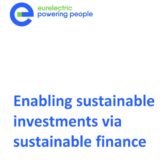Eurelectric releases its position paper “Enabling sustainable investments via sustainable finance”, highlighting the critical role of the financial system for accelerating investments in the transition-enabling technologies.
Committed to reach carbon neutrality by 2045, the EU electricity sector aims at providing solutions for the decarbonisation of the entire EU economy. Our recent Decarbonisation Pathways study shows this objective will require annual investments of 89-111 billion euros. To allow for this investment to happen and create the investors’ confidence, efficient market-based frameworks and market design will be crucial.
Our industry ensures the respect of sustainability values throughout the entire value chain and supports the transformation of existing assets towards a carbon-neutral society.
Going further, Europe needs a technology-neutral approach on EU’s taxonomy and solid technical screening criteria to identify environmentally sustainable projects. The proposed EU taxonomy must accelerate investments and innovation in all transition-enabling technologies and related business models
The European power sector therefore welcomes the EU Commission’s Action Plan on Sustainable Finance, incentivising innovation and ensuring the deployment of best solutions for decarbonisation, electrification and digitalisation. Europe must build a financial system that enables sustainable economic development, fosters social integration, protects the environment and limits the impact on nature.
Together with this, the European Green Bond Standard comes as a clear catalyst for mobilising the financial resources needed for climate change and cost-effective investments in innovative, transition-enabling and carbon-neutral technologies. As a member of the European Commission Technical Expert Group (TEG) on Sustainable Finance, Eurelectric is specifically engaged in discussions on the EU Green Bond Standard. To reach its full potential, further developments must include clear-cut definitions; implement monitoring, reporting and evaluation mechanisms; and couple green bonds with incentive policies.






